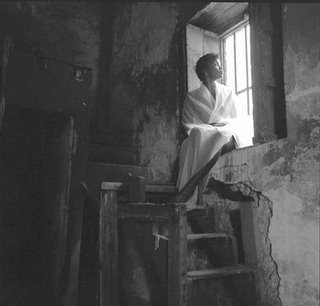 This photo was made in an old building in Havana Vieja. I liked the old run down buildings, the bright light, and the windows and doors that streamed the light through. A series of these photos is on my web site, www.riowatauga-art.com
This photo was made in an old building in Havana Vieja. I liked the old run down buildings, the bright light, and the windows and doors that streamed the light through. A series of these photos is on my web site, www.riowatauga-art.com
On the street in Havana you hear the young people greet each other with the phrase, "Que Bola?" this is equivalent to our US slang phrase "What's up?" This Cuba photo blog is morphing into my general blog with a wider scope of photos and commentary.This will enable me to keep my website clean and still have space to babble.
Monday, September 11, 2006
La Luz
 This photo was made in an old building in Havana Vieja. I liked the old run down buildings, the bright light, and the windows and doors that streamed the light through. A series of these photos is on my web site, www.riowatauga-art.com
This photo was made in an old building in Havana Vieja. I liked the old run down buildings, the bright light, and the windows and doors that streamed the light through. A series of these photos is on my web site, www.riowatauga-art.com
Wednesday, August 23, 2006
Babalao with Chicken
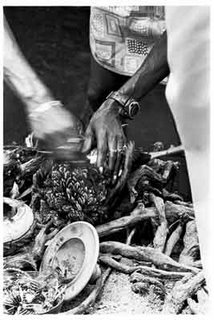 Ernesto, the Babalao at the ceremony, is sacrificing the chicken. There was an array of bowls, fruits, nuts, and bottles of rum set up. Some of these items then had chicken blood sprinkled over them. After this people danced, sang, and the drums beat louder and louder until one or two dancers fell into trances and dropped to the ground-I think from both emotional, spiritual, and physical exhaustion. It was hot, humid, and they had danced non-stop for more than an hour. When we went to the beach and Maria danced in the edge of the ocean she eventually collapsed and was simply floundering in the surf. My old life guard instincts kicked in and I bounded into the surf as if I was once again 19 and back at the beach in South Carolina. It was an easy rescue.
Ernesto, the Babalao at the ceremony, is sacrificing the chicken. There was an array of bowls, fruits, nuts, and bottles of rum set up. Some of these items then had chicken blood sprinkled over them. After this people danced, sang, and the drums beat louder and louder until one or two dancers fell into trances and dropped to the ground-I think from both emotional, spiritual, and physical exhaustion. It was hot, humid, and they had danced non-stop for more than an hour. When we went to the beach and Maria danced in the edge of the ocean she eventually collapsed and was simply floundering in the surf. My old life guard instincts kicked in and I bounded into the surf as if I was once again 19 and back at the beach in South Carolina. It was an easy rescue.
Sunday, August 13, 2006
Sacrifice
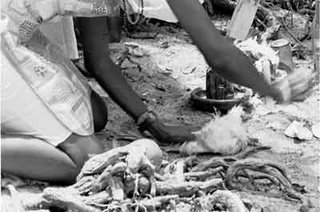 Most of the Santeria ceremonies involve a sacrifice, typically a chicken. Here Maria, the person for whom the ceremony was being held, handles the sacrificed chicken. She suffers from Hepatitis C infection, had been losing weight and had visited a babalao who had recommended the sacrifice and ceremony as a means of asking a spirit for help in attaining better health.
Most of the Santeria ceremonies involve a sacrifice, typically a chicken. Here Maria, the person for whom the ceremony was being held, handles the sacrificed chicken. She suffers from Hepatitis C infection, had been losing weight and had visited a babalao who had recommended the sacrifice and ceremony as a means of asking a spirit for help in attaining better health.
Friday, August 04, 2006
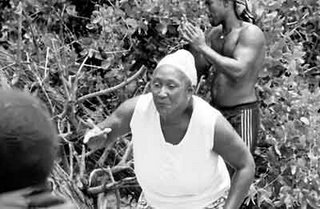 This woman is dancing in time to the chanting of Antonio and the beat of several drums-a bongo and a conga drum that were brought for the ceremony. The rhythm is infectious. Two of the dancers became transfixed by the music and the dancing and went into trances. Maria, one of the two, fell in the surf. My old lifeguard instincts were still present I suppose for I crashed into the surf to the rescue. It was a fascinating experience.
This woman is dancing in time to the chanting of Antonio and the beat of several drums-a bongo and a conga drum that were brought for the ceremony. The rhythm is infectious. Two of the dancers became transfixed by the music and the dancing and went into trances. Maria, one of the two, fell in the surf. My old lifeguard instincts were still present I suppose for I crashed into the surf to the rescue. It was a fascinating experience.
Monday, July 24, 2006
Antonio y Ellagua
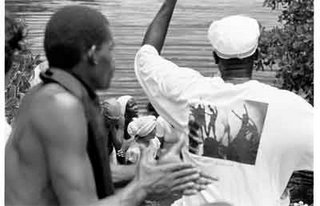 One afternoon Roberto and I were talking. He asked me if I wanted to go to a Santeria ceremony the next day. I asked if the students could go and he said "OK." WE commandeered a van the next morning and drove out toward Cojimar and turned off the road toward the beach. We ended up at a small beach with a Rapido and nothing else. The key thing at the beach was that a freshwater river entered the ocean there. The Babalao had told Roberto and Maria that this was the type of place they should find for the ceremony. Antonio, who has been pictured before, is shown here wearing his tee shirt I had given him a year or two before. It was for an exhibition and the photo on the shirt was made at the Tropicana. Antonio sang, chanted, drank rum and puffed his cigar for several hours non-stop during the ceremony. I don't know how much of this was real, how much for show, but it was a fascinating event.
One afternoon Roberto and I were talking. He asked me if I wanted to go to a Santeria ceremony the next day. I asked if the students could go and he said "OK." WE commandeered a van the next morning and drove out toward Cojimar and turned off the road toward the beach. We ended up at a small beach with a Rapido and nothing else. The key thing at the beach was that a freshwater river entered the ocean there. The Babalao had told Roberto and Maria that this was the type of place they should find for the ceremony. Antonio, who has been pictured before, is shown here wearing his tee shirt I had given him a year or two before. It was for an exhibition and the photo on the shirt was made at the Tropicana. Antonio sang, chanted, drank rum and puffed his cigar for several hours non-stop during the ceremony. I don't know how much of this was real, how much for show, but it was a fascinating event.
Friday, July 21, 2006
Hanging Out
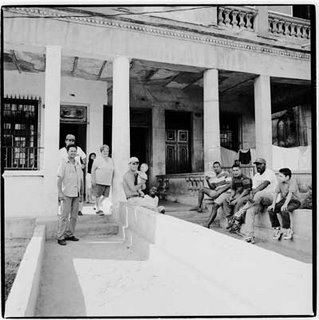 It is a hot Saturday afternoon. All these folks are out in their front yard which sits on Linea. They are joking, drinking rum, and having a good time. All of them live in apartments in the house behind them. The old homes in Vedado and some in Miramar have been divided up into apartments. Note how one apartment has been repainted and another has not. Almost all the old homes not taken over by businesses or rented to embassies and their officials have been sub-divided like this. Some are reasonably well maintained. Others are not. I guess that it is a lot like public housing in most parts of the world.
It is a hot Saturday afternoon. All these folks are out in their front yard which sits on Linea. They are joking, drinking rum, and having a good time. All of them live in apartments in the house behind them. The old homes in Vedado and some in Miramar have been divided up into apartments. Note how one apartment has been repainted and another has not. Almost all the old homes not taken over by businesses or rented to embassies and their officials have been sub-divided like this. Some are reasonably well maintained. Others are not. I guess that it is a lot like public housing in most parts of the world.
Tuesday, July 18, 2006
Three clerks
 These guys who are enjoying their morning cigars were all working in a small shop. There was not much merchandise for sale and one person certainly could have done the job. There are a lot of situations like this throughout Cuba. There is definitely no thought given to efficiency. Labor is cheap, and an effort is made to have everybody "employed." A friend of mine once told me that when he was working in Havana as a press photographer there were two people in the elevator of his hotel at all times. One person asked "What floor?" Then, the other person pressed the button.
These guys who are enjoying their morning cigars were all working in a small shop. There was not much merchandise for sale and one person certainly could have done the job. There are a lot of situations like this throughout Cuba. There is definitely no thought given to efficiency. Labor is cheap, and an effort is made to have everybody "employed." A friend of mine once told me that when he was working in Havana as a press photographer there were two people in the elevator of his hotel at all times. One person asked "What floor?" Then, the other person pressed the button.
Sunday, July 16, 2006
Private Food Stand
 This food stand has better offerings than the state owned one. Here the producers sell their products and then they are taxed. Their products are better although far from outstanding. Most of the choice produce goes to the hotels and restaurants that cater to the tourist industry. Also some is exported, most of the pineapple, for instance, goes to Switzerland I have been told. At the house where we generally stay, the owner goes out in the morning and returns later with several bags of good vegetables and fruits. I don't know where he gets it, I don't ask, I just realize that the bolsa negra is alive and well.
This food stand has better offerings than the state owned one. Here the producers sell their products and then they are taxed. Their products are better although far from outstanding. Most of the choice produce goes to the hotels and restaurants that cater to the tourist industry. Also some is exported, most of the pineapple, for instance, goes to Switzerland I have been told. At the house where we generally stay, the owner goes out in the morning and returns later with several bags of good vegetables and fruits. I don't know where he gets it, I don't ask, I just realize that the bolsa negra is alive and well.
Saturday, July 15, 2006
State Owned Produce Stand
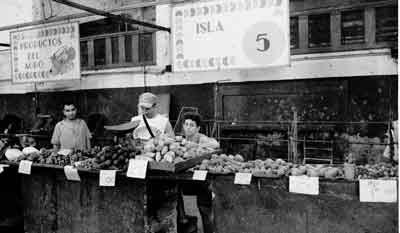
In this stand at the produce section of the market are the vendors for the state. The produce comes from state owned and run farms. Hardly anyone shops there. The produce is smaller, more discolored, and is not as fresh as that sold in other stands. As a consequence there are rarely customers shopping. The vendors all seem quite bored and resigned to their situation.
Thursday, July 13, 2006
More Market
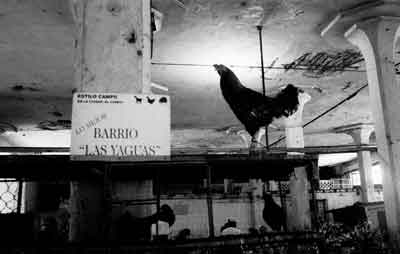 Upstairs at the market is the meat department. There are slabs of beef, pork, and various butchered cuts of meat sold here. Nothing is refrigerated. In the back of the meat market is the live section which has chickens, guineas, and other fowl for sale. This is a place where life and death, existence and non-existence, and to some extent the balance among living things comes to its cross roads. There are not many vegetarians in Cuba in my experience, but there is not much to please the palate of a serious meat eater. I find it fairly easy to eat a lot of vegetable-fruit meals, leaving the meat and seafood to others. Needless to say, there is not a pandemic of obesity-childhood or otherwise in Cuba.
Upstairs at the market is the meat department. There are slabs of beef, pork, and various butchered cuts of meat sold here. Nothing is refrigerated. In the back of the meat market is the live section which has chickens, guineas, and other fowl for sale. This is a place where life and death, existence and non-existence, and to some extent the balance among living things comes to its cross roads. There are not many vegetarians in Cuba in my experience, but there is not much to please the palate of a serious meat eater. I find it fairly easy to eat a lot of vegetable-fruit meals, leaving the meat and seafood to others. Needless to say, there is not a pandemic of obesity-childhood or otherwise in Cuba.
Tuesday, July 11, 2006
Free Market
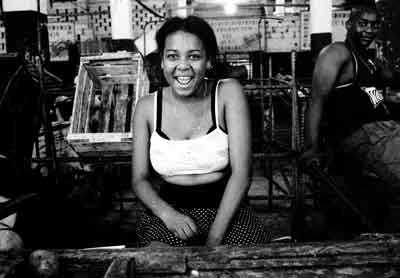 One of my favorite things to do while in Havana is to go the Free Market over in Cerro. It is at a big crossroads, full of food vendors and lots of activity. Around the outside are several shops that sell the relics and implements needed for various santeria rites. One sees people there with live chickens and it is assumed that they are headed for sacrifice. Inside the majority of people are happy and are having a good time. I think this girl has a great smile. Prices are ridiculously low until you realize that you as an Anglo are being charged in dollars and the Cubans are paying in pesos, this is a convenient conversion method, but it is hardly correct. I don't complain though, it is not a lot, the fruit is fresh and tasty, and the money helps the people to survive a few more days. One can spend an afternoon there without problem and if you like to make photos of people, then you can spend several days.
One of my favorite things to do while in Havana is to go the Free Market over in Cerro. It is at a big crossroads, full of food vendors and lots of activity. Around the outside are several shops that sell the relics and implements needed for various santeria rites. One sees people there with live chickens and it is assumed that they are headed for sacrifice. Inside the majority of people are happy and are having a good time. I think this girl has a great smile. Prices are ridiculously low until you realize that you as an Anglo are being charged in dollars and the Cubans are paying in pesos, this is a convenient conversion method, but it is hardly correct. I don't complain though, it is not a lot, the fruit is fresh and tasty, and the money helps the people to survive a few more days. One can spend an afternoon there without problem and if you like to make photos of people, then you can spend several days.
Saturday, July 08, 2006
Sitting on La Rampa
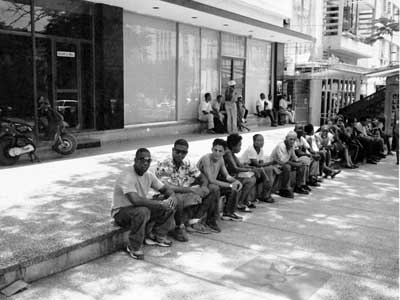 Calle 23 is a busy street, it is main street in Vedado. It stretches up from the Malecon past the Habana Libre Hotel heading up in the general direction of the University. It has shops, markets, a couple of dance clubs and a great jazz club along the way. All of the airlines have their offices there and there are several travel agents. My friend Roberto goes by the cell phone office to buy some more time on his phone each time he has spare money. There is always a crowd of people. Many just hang out. Hanging out is a very popular pastime in Havana. In most cities I see people walking from one place to another. Those who are sitting on benches or just standing around are usually identifiable as tourists or retirees. It is different in Havana. Young men will stop you and ask you where you are from. A typical American might question this intrusion or fear they were being hustled. Sometimes you are, especially when the next question is "You want cigars?" At other times you discover the person is just interested, wants to make conversation, ask you something about the US, or tell you about their father who lives in Hialeah or Fort Lauderdale. You realize just how sheltered or out of touch many Cubans are when a bright seeming young man asks you " Where is the weather best, Miami or Detroit?"
Calle 23 is a busy street, it is main street in Vedado. It stretches up from the Malecon past the Habana Libre Hotel heading up in the general direction of the University. It has shops, markets, a couple of dance clubs and a great jazz club along the way. All of the airlines have their offices there and there are several travel agents. My friend Roberto goes by the cell phone office to buy some more time on his phone each time he has spare money. There is always a crowd of people. Many just hang out. Hanging out is a very popular pastime in Havana. In most cities I see people walking from one place to another. Those who are sitting on benches or just standing around are usually identifiable as tourists or retirees. It is different in Havana. Young men will stop you and ask you where you are from. A typical American might question this intrusion or fear they were being hustled. Sometimes you are, especially when the next question is "You want cigars?" At other times you discover the person is just interested, wants to make conversation, ask you something about the US, or tell you about their father who lives in Hialeah or Fort Lauderdale. You realize just how sheltered or out of touch many Cubans are when a bright seeming young man asks you " Where is the weather best, Miami or Detroit?"
Tuesday, July 04, 2006
America in Cuba
 All about one sees the remnants of the American presence in Cuba. Most of the Cuban people express their strong fondness for Americans. In spite of the official differences between the governments at a street level the people can get along just fine. I think most people would like to see both countries live up to the ideals of the Fourth of July and its representation of freedom. More and more those freedoms are being lost and this trend must stop. Those who treasure freedom must stand up not only against intruders or terrorists, but against over reaching by insulated, out of touch governments. This premise is applicable to both the USA and Cuba.
All about one sees the remnants of the American presence in Cuba. Most of the Cuban people express their strong fondness for Americans. In spite of the official differences between the governments at a street level the people can get along just fine. I think most people would like to see both countries live up to the ideals of the Fourth of July and its representation of freedom. More and more those freedoms are being lost and this trend must stop. Those who treasure freedom must stand up not only against intruders or terrorists, but against over reaching by insulated, out of touch governments. This premise is applicable to both the USA and Cuba.
Saturday, July 01, 2006
Plaza in Cienfuegoes
 Another picture of Cienfuegoes. The plaza is full of school kids most afternoons. This man is on his way to work as a musician. All of the buildings surrounding the plaza are fairly well kept and painted mainly soft pastel, tropical colors. It was a bit difficult to find much in the way of good food in Cienfuegoes. There are a few places frequented by the tour buses, but the smaller restaurants and cafes left a lot to be desired.
Another picture of Cienfuegoes. The plaza is full of school kids most afternoons. This man is on his way to work as a musician. All of the buildings surrounding the plaza are fairly well kept and painted mainly soft pastel, tropical colors. It was a bit difficult to find much in the way of good food in Cienfuegoes. There are a few places frequented by the tour buses, but the smaller restaurants and cafes left a lot to be desired.
Thursday, June 29, 2006
Local Transportation
 These horse and wagon outfits are very common in many of the towns of Cuba. Here in Ceinfuegoes one finds this arrangement all over the place. People hop on and off, socialize, and all seem perfectly content with the horse drawn wagon as their means of getting about. Needless to say, the gas production exceeds the gas consumption. These vehicles pretty much run on straw and grain. I realize that this is archaic to most of us worldy moderns, but it works and meets the needs of the system. When people don't have big or important jobs, rushing about is much less "important."
These horse and wagon outfits are very common in many of the towns of Cuba. Here in Ceinfuegoes one finds this arrangement all over the place. People hop on and off, socialize, and all seem perfectly content with the horse drawn wagon as their means of getting about. Needless to say, the gas production exceeds the gas consumption. These vehicles pretty much run on straw and grain. I realize that this is archaic to most of us worldy moderns, but it works and meets the needs of the system. When people don't have big or important jobs, rushing about is much less "important."
Sunday, June 25, 2006
CDR in Cienfuegoes
 Cienfuegoes is such a beautiful place it requires color film. Even if like me, you are a total amateur in color, you know you have to do it. The pastels of the buildings are gorgeous. The quaintness of the horse drawn carriages which provide the main form of public transportation add to the charm. They each have a kerosene lantern hanging beneath them so that they can be seen at night. Very much a tourist destination the main drawback are the beggars and scammers. It seems everyone in Cienfuegoes has an angle or a deal for you. I have had business deals proposed by university professors, standard propositions for food, lodging, girls, boys, and cigars. At least when you say "No" most of them leave you alone after that, but it does make it less pleasant. This is hardly a Cuban thing, it occurs throughout out the world, especially the third world and the emerging nations. I have experienced it in Mexico, Puerto Rico, Morocco, and surprisingly in Budapdest. No doubt were I more widely traveled, I would have experienced it elsewhere. None the less, Cienfuegoes is a beautiful city.
Cienfuegoes is such a beautiful place it requires color film. Even if like me, you are a total amateur in color, you know you have to do it. The pastels of the buildings are gorgeous. The quaintness of the horse drawn carriages which provide the main form of public transportation add to the charm. They each have a kerosene lantern hanging beneath them so that they can be seen at night. Very much a tourist destination the main drawback are the beggars and scammers. It seems everyone in Cienfuegoes has an angle or a deal for you. I have had business deals proposed by university professors, standard propositions for food, lodging, girls, boys, and cigars. At least when you say "No" most of them leave you alone after that, but it does make it less pleasant. This is hardly a Cuban thing, it occurs throughout out the world, especially the third world and the emerging nations. I have experienced it in Mexico, Puerto Rico, Morocco, and surprisingly in Budapdest. No doubt were I more widely traveled, I would have experienced it elsewhere. None the less, Cienfuegoes is a beautiful city.
Thursday, June 22, 2006
Pot Calls Kettle Black!
 A school in Miami has taken a book about Cuba from its library at the request of several parents. Apparently the book paints a to favorable picture of a child's life in Cuba and this is against the perception of what Castro has visited upon those people and their island home. No matter how one spins this it is censorship, and it is political censorship, and it is a really dumb thing to do. If one is trying to describe how thought and freedom are suppressed, you hardly help your cause by suppressing a book that doesn't fit your preconvceived notions. One of the first small steps toward fascism is trying to control the flow of information and ideas to the people. It is important to let people, including children, find the truth by themselves. Certainly parents and teachers must help, but practicing censorship is just an object lesson in totalitarianism, The photo above is not a good photo, but it does show the book stalls in Plaza Armas. The book sellers are there several days a week. Most of the books are communist era political treatises and /or history books that recount previous communist glories. Occasionally one finds a book by Marti, a book of poems by N. Guillen, an old Hemingway novel or something like that. These books show the vestiges of control that existed and to some extent still exists in Cuba. Unfortunately, the same thing is sprouting like Kudzu in the United States.
A school in Miami has taken a book about Cuba from its library at the request of several parents. Apparently the book paints a to favorable picture of a child's life in Cuba and this is against the perception of what Castro has visited upon those people and their island home. No matter how one spins this it is censorship, and it is political censorship, and it is a really dumb thing to do. If one is trying to describe how thought and freedom are suppressed, you hardly help your cause by suppressing a book that doesn't fit your preconvceived notions. One of the first small steps toward fascism is trying to control the flow of information and ideas to the people. It is important to let people, including children, find the truth by themselves. Certainly parents and teachers must help, but practicing censorship is just an object lesson in totalitarianism, The photo above is not a good photo, but it does show the book stalls in Plaza Armas. The book sellers are there several days a week. Most of the books are communist era political treatises and /or history books that recount previous communist glories. Occasionally one finds a book by Marti, a book of poems by N. Guillen, an old Hemingway novel or something like that. These books show the vestiges of control that existed and to some extent still exists in Cuba. Unfortunately, the same thing is sprouting like Kudzu in the United States.
Tuesday, June 20, 2006
Playing in the Band
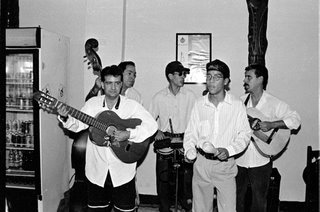 In this bar on Obispo Street, Lluvia del Oro, or something like that, I encountered this local band. They were all serious music students at the University, several were music teachers on the side, and they really enjoyed playing together. As almost all of these sorts of places open up to the street, the music spills out into the streets at all hours of the day and night, and lends a festive atmsophere. It is always interesting to take a walk in a city in the afternoon and hear someone practicing their music. It seems that the music, unstructured as it might be, wafts freely into the street as a benefit of just being there. More than once , especially in Havana, I have stopped and sat on a wall, the curb, on in an open air café just to listen to someone play and practice their horn or clarinet. The mystery of not knowing exactly who it is and from where it comes, makes it even more fun to do this.
In this bar on Obispo Street, Lluvia del Oro, or something like that, I encountered this local band. They were all serious music students at the University, several were music teachers on the side, and they really enjoyed playing together. As almost all of these sorts of places open up to the street, the music spills out into the streets at all hours of the day and night, and lends a festive atmsophere. It is always interesting to take a walk in a city in the afternoon and hear someone practicing their music. It seems that the music, unstructured as it might be, wafts freely into the street as a benefit of just being there. More than once , especially in Havana, I have stopped and sat on a wall, the curb, on in an open air café just to listen to someone play and practice their horn or clarinet. The mystery of not knowing exactly who it is and from where it comes, makes it even more fun to do this.
Saturday, June 17, 2006
Proud Father
 This man was really proud of his daughter. They had a small business doing a little bit of photography for the neighborhood folks. Both were interested in my camera and wanted to show me some of their work. They seemed to enjoy talking photography, even to a stranger. I must confess that I am rarely treated as a "stranger" while in Havana. Most people have questions about the US, about life there, and it seems they all have a cousin or sibling who lives there. On the Father's Day that I was there a festive atmosphere prevailed as I walked about that afternoon. Lots of music, food being prepared, another important day to celebrate--being happy was the order of the day.
This man was really proud of his daughter. They had a small business doing a little bit of photography for the neighborhood folks. Both were interested in my camera and wanted to show me some of their work. They seemed to enjoy talking photography, even to a stranger. I must confess that I am rarely treated as a "stranger" while in Havana. Most people have questions about the US, about life there, and it seems they all have a cousin or sibling who lives there. On the Father's Day that I was there a festive atmosphere prevailed as I walked about that afternoon. Lots of music, food being prepared, another important day to celebrate--being happy was the order of the day.
Thursday, June 15, 2006
Happy Father's Day
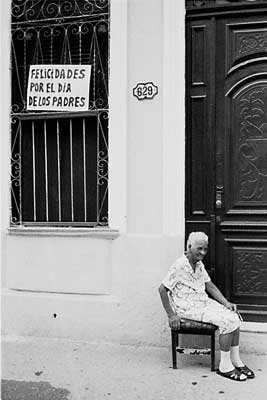 I was in Havana three years ago for Father's Day. The family where I was staying had a party for me and their father. Each of us got a bottle of good rum, a poem, and a song sung by the children. It was a terrific event. I encountered this lady with her sign on the street several blocks away. Holidays and events like we had are a big part of Cuban life. A poem, a special dessert, children singing a song--these are the things that add real soul to life, the Cubans have that in abundance.
I was in Havana three years ago for Father's Day. The family where I was staying had a party for me and their father. Each of us got a bottle of good rum, a poem, and a song sung by the children. It was a terrific event. I encountered this lady with her sign on the street several blocks away. Holidays and events like we had are a big part of Cuban life. A poem, a special dessert, children singing a song--these are the things that add real soul to life, the Cubans have that in abundance.
Tuesday, June 13, 2006
Che lives!
 This is not a Cuba photo. I took it in Paris several years ago at a parade on the St. Germain de Pres in protest of the bombing of Baghdad. Since then I have photographed people wearing Che tee shirts in all sorts of places from the southeastern US to downtown Budapest. I put it up today to mark the cutting of the power to the US Special Interests Section in Havana. They have recently been broadcasting propaganda and flashing lighted signs with messages that are critical of the government, so the governement simply cut the flow of electricity. The US Special Interests Section is now running on generator power. I think this is symbolic of the embargo. It is a generally bad idea that is losing power as time progresses and it is simply a matter of time. Waiting on Fidel to die will hardly be considered a victory no matter how much spin is applied.
This is not a Cuba photo. I took it in Paris several years ago at a parade on the St. Germain de Pres in protest of the bombing of Baghdad. Since then I have photographed people wearing Che tee shirts in all sorts of places from the southeastern US to downtown Budapest. I put it up today to mark the cutting of the power to the US Special Interests Section in Havana. They have recently been broadcasting propaganda and flashing lighted signs with messages that are critical of the government, so the governement simply cut the flow of electricity. The US Special Interests Section is now running on generator power. I think this is symbolic of the embargo. It is a generally bad idea that is losing power as time progresses and it is simply a matter of time. Waiting on Fidel to die will hardly be considered a victory no matter how much spin is applied.
Sunday, June 11, 2006
Bosque de Habana
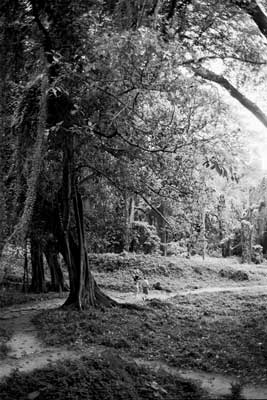 This forested area along the bank of the Almendares river is a gorgeous park. There are large tropical trees, beautiful plants and ferns, and the sound of the river flowing to the sea. As one walks through the park the remnants of Santeria ceremonies and animal sacrifices are encountered. I don't think I would want to be in the park after dark, but in the daytime it is beautiful. Unfortunately it suffers the fate of many nice things in Cuba-no maintenance. It is littered, unclean, and has virtually no facilities for the people. I have missed my annual trip to Cuba this year. First time in 6 years I haven't been there for at least a couple of weeks. When I reflect on how much I miss it, I can't imagine the effect having left Cuba and friends behind would have on oneself. It must be a profoundly deep and painful thing to experience.
This forested area along the bank of the Almendares river is a gorgeous park. There are large tropical trees, beautiful plants and ferns, and the sound of the river flowing to the sea. As one walks through the park the remnants of Santeria ceremonies and animal sacrifices are encountered. I don't think I would want to be in the park after dark, but in the daytime it is beautiful. Unfortunately it suffers the fate of many nice things in Cuba-no maintenance. It is littered, unclean, and has virtually no facilities for the people. I have missed my annual trip to Cuba this year. First time in 6 years I haven't been there for at least a couple of weeks. When I reflect on how much I miss it, I can't imagine the effect having left Cuba and friends behind would have on oneself. It must be a profoundly deep and painful thing to experience.
Thursday, June 08, 2006
Service Station-La Rampa y Malecon
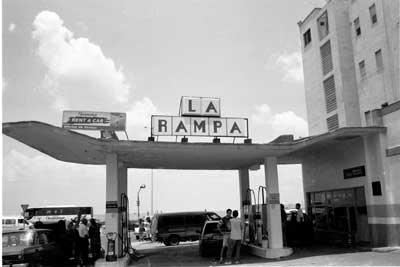 This service station is at the corner where La Rampa or 23rd Street ends at the Malecon. This area is jammed most nights with young people looking for something to do, somewhere to go, and filled with the ennui of a hot summer night and not much to look forward to. I grew up at the beach and I used to hang out at night around the dance pads and juke boxes adjacent to the sand dunes of South Carolina's coast. Like the Cuban youth we danced, drank beer, and flirted with the girls. Most of us were looking forward to finishing college and having promising careers or jobs. It was a hopeful time, there is little of that in the crowd at the corner of La Rampa and the Malecon most nights.
This service station is at the corner where La Rampa or 23rd Street ends at the Malecon. This area is jammed most nights with young people looking for something to do, somewhere to go, and filled with the ennui of a hot summer night and not much to look forward to. I grew up at the beach and I used to hang out at night around the dance pads and juke boxes adjacent to the sand dunes of South Carolina's coast. Like the Cuban youth we danced, drank beer, and flirted with the girls. Most of us were looking forward to finishing college and having promising careers or jobs. It was a hopeful time, there is little of that in the crowd at the corner of La Rampa and the Malecon most nights.
Tuesday, June 06, 2006
Camello
 These are big hump backed buses pulled by large truck-tractors. The entire rig resembles a camel's back hence the name, camello. They are always jammed full of passengers. Fortunately most of the people are used to lines and crowded conditions, so everyone gets along. According to a friend of mine, if you ride it far enough, you will steal your own stuff back. It only costs a couple of pesos to ride. In the country side, one doesn't encounter buses, you are more apt to see carts pulled by horses, trucks, or wagons towed by old farm tractors. Transportation is one of the larger problems in the country it seems. There is not enough fuel, and there are not enough functional vehicles.
These are big hump backed buses pulled by large truck-tractors. The entire rig resembles a camel's back hence the name, camello. They are always jammed full of passengers. Fortunately most of the people are used to lines and crowded conditions, so everyone gets along. According to a friend of mine, if you ride it far enough, you will steal your own stuff back. It only costs a couple of pesos to ride. In the country side, one doesn't encounter buses, you are more apt to see carts pulled by horses, trucks, or wagons towed by old farm tractors. Transportation is one of the larger problems in the country it seems. There is not enough fuel, and there are not enough functional vehicles.
Friday, May 26, 2006
Scooter
 Throughout the world the desire of kids to play is overwhelming. They are resourceful, creative, andf will work very hard to make a toy or something to play with. I have helped Cuban boys wrap tape into a ball so that they can then play stickball in the street. These guys are even more inventive and mechanically talented. They are building their own "blade". It is made from scraps of lumber they have found and old roller skate parts. The typical child in Cuba is certainly not spoiled by excess nor do they grow up as part of a consumer society. They do like to play, they play outside in the sun and heat, and they are resourceful in creating their playthings. I was fascinated by the number of games and the hours spent by the boys in the neighborhood where I stayed in Havana when I brought them a simple rubber ball to play with-it was amazing how thrilled they were.
Throughout the world the desire of kids to play is overwhelming. They are resourceful, creative, andf will work very hard to make a toy or something to play with. I have helped Cuban boys wrap tape into a ball so that they can then play stickball in the street. These guys are even more inventive and mechanically talented. They are building their own "blade". It is made from scraps of lumber they have found and old roller skate parts. The typical child in Cuba is certainly not spoiled by excess nor do they grow up as part of a consumer society. They do like to play, they play outside in the sun and heat, and they are resourceful in creating their playthings. I was fascinated by the number of games and the hours spent by the boys in the neighborhood where I stayed in Havana when I brought them a simple rubber ball to play with-it was amazing how thrilled they were.
Saturday, May 06, 2006
Tropicana, 2000
 This was a beautiful night-warm, slight breeze, not too humid. We went to the Tropicana and this picture of the dancers in the smoke was probably more luck than anything else. The Tropicana is probably the one single constant that has existed in Havana from back in the 1940s until the present. While the cost of admission is well beyond the reach of most Cubans, there are always plenty of visitors and upper class Cubans who are present to cheer on the dancers and musicians.
This was a beautiful night-warm, slight breeze, not too humid. We went to the Tropicana and this picture of the dancers in the smoke was probably more luck than anything else. The Tropicana is probably the one single constant that has existed in Havana from back in the 1940s until the present. While the cost of admission is well beyond the reach of most Cubans, there are always plenty of visitors and upper class Cubans who are present to cheer on the dancers and musicians.
Thursday, April 20, 2006
Jinetera with tattoo
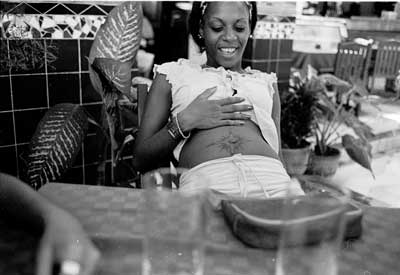 This young woman with several of here friends sat down at my table at Casa Marina in H. Vieja one hot afternoon. I don't think they saw me as a prospect for anythng more than a cool drink. I obligingly sprang for a Fanta orange for all three of them. They enjoyed playing with my camera. I told them they must pose for pictures in return for the orange soda. This gal was very pround of the sunburst tattooed around her belly button. All of them were clean, nice, and reasonably well educated. Having fun is as much of these girls agenda as is being a working prostitute. For many the sex scene in Havana is more like the singles bar scene in the states than the street hooker scene that occurs in US cities.
This young woman with several of here friends sat down at my table at Casa Marina in H. Vieja one hot afternoon. I don't think they saw me as a prospect for anythng more than a cool drink. I obligingly sprang for a Fanta orange for all three of them. They enjoyed playing with my camera. I told them they must pose for pictures in return for the orange soda. This gal was very pround of the sunburst tattooed around her belly button. All of them were clean, nice, and reasonably well educated. Having fun is as much of these girls agenda as is being a working prostitute. For many the sex scene in Havana is more like the singles bar scene in the states than the street hooker scene that occurs in US cities.
Tuesday, April 18, 2006
Smoke on the Stairs
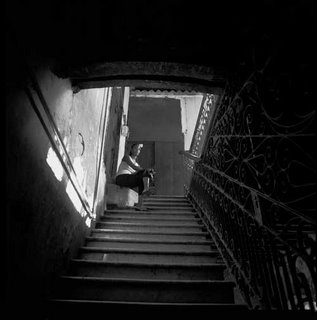 Many of the buildings of Havana Vieja have dark, somewhat foreboding stairs wells just inside their doors. Often they are dark near the street, but rise up toward light coming in from open windows or courtyards on the second level. Many people spend much of their social life in these dark, cool stair wells. It is a chance to remain cool, visit neighbors, and let children play together on the ground level. Here, Yunieski has stopped to relax with a smoke before heading back out to the hot, sunshine of the street.
Many of the buildings of Havana Vieja have dark, somewhat foreboding stairs wells just inside their doors. Often they are dark near the street, but rise up toward light coming in from open windows or courtyards on the second level. Many people spend much of their social life in these dark, cool stair wells. It is a chance to remain cool, visit neighbors, and let children play together on the ground level. Here, Yunieski has stopped to relax with a smoke before heading back out to the hot, sunshine of the street.
Wednesday, April 12, 2006
Woman on Stairs
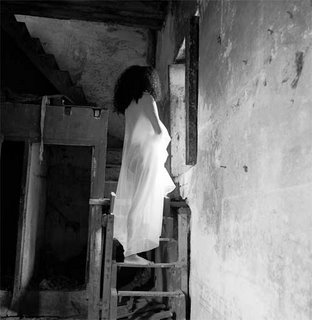 I made a series of these sort of pictures in 2004 while in Cuba. I obtained the use of several very old, decrepit buildings in Habana Vieja, hired several models, and had an excellent assistant. I like the beauty suggested by this woman in the midst of the old surroundings. It sort of represents an existential view that life is pretty much what you make of it and no one really deserves more than a chance to try to make something out of it.
I made a series of these sort of pictures in 2004 while in Cuba. I obtained the use of several very old, decrepit buildings in Habana Vieja, hired several models, and had an excellent assistant. I like the beauty suggested by this woman in the midst of the old surroundings. It sort of represents an existential view that life is pretty much what you make of it and no one really deserves more than a chance to try to make something out of it.
Tuesday, April 11, 2006
Ancon Beach
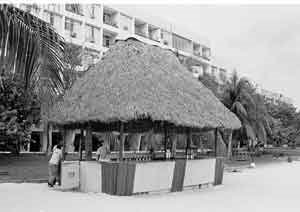 This cabana is the bar on the beach at the Ancon Hotel near Trinidad. The ocean is warm, the beach is nice, and the hotel is fairly nice by Cuban standards. Both the Ancon and the Costa Sur Hotels were constructed during the Soviet days and subsequently renovated. Beach vacations were used to reward workers. They certainly are not as luxurious as the hotels at Varadero, but do provide a nice and economical beach trip. Since many of the tourists in Cuba are sort of the budget minded European or South American tourists, these beaches are popular during the main season.
This cabana is the bar on the beach at the Ancon Hotel near Trinidad. The ocean is warm, the beach is nice, and the hotel is fairly nice by Cuban standards. Both the Ancon and the Costa Sur Hotels were constructed during the Soviet days and subsequently renovated. Beach vacations were used to reward workers. They certainly are not as luxurious as the hotels at Varadero, but do provide a nice and economical beach trip. Since many of the tourists in Cuba are sort of the budget minded European or South American tourists, these beaches are popular during the main season.
Tuesday, April 04, 2006
Shave and a Hair Cut, 2 Pesos
 There are many old traditional barber shops in Havana. They are meeting places, parlors for conversation, and dominos just like they are in the USA. A lot of sports and a little bit of politics get discussed as well. Many of those discussions get too animated and loud for a barber shop. Discussing things like that in close proximity to straight razors is not a particularly good idea. Most are very clean. The barbers wear clean starched smocks, and it is a genuinely professional atmosphere. One of the more humane and meaningful things about the neighborhood societies that exist throughout the city.
There are many old traditional barber shops in Havana. They are meeting places, parlors for conversation, and dominos just like they are in the USA. A lot of sports and a little bit of politics get discussed as well. Many of those discussions get too animated and loud for a barber shop. Discussing things like that in close proximity to straight razors is not a particularly good idea. Most are very clean. The barbers wear clean starched smocks, and it is a genuinely professional atmosphere. One of the more humane and meaningful things about the neighborhood societies that exist throughout the city.
Monday, April 03, 2006
 This gentleman lives across the street from where we usually stay in Havana. He sells old currency, post cards, and a few old magazines. He is sort of the neighborhood watch guy I suppose. He is always in his doorway, behind a little table upon which he spreads his merchandise, and is quite friendly. Many people have little streetside businesses like this. Some refill lighters with insecticides using the flammable properties of the propellant. Others sell coffee or juice, some sell cookies, some repair clothes or shoes. Really just about anything to eke out a little more money to put toward survival.
This gentleman lives across the street from where we usually stay in Havana. He sells old currency, post cards, and a few old magazines. He is sort of the neighborhood watch guy I suppose. He is always in his doorway, behind a little table upon which he spreads his merchandise, and is quite friendly. Many people have little streetside businesses like this. Some refill lighters with insecticides using the flammable properties of the propellant. Others sell coffee or juice, some sell cookies, some repair clothes or shoes. Really just about anything to eke out a little more money to put toward survival.
Sunday, April 02, 2006
Caneys and Rafael
 I met these two guys in Santiago. They told me that they were both "clowns". They had retired from a circus and now worked only at birthday parties and affairs like that, held mainly for children. I had never encountered a circus in Cuba and since I still haven't, so I don't know if they were joshing me or not. Both were extremely affable and more than willing to have me make some photos of them. Circus or not, it was fun to meet and photograph them and made for a good day.
I met these two guys in Santiago. They told me that they were both "clowns". They had retired from a circus and now worked only at birthday parties and affairs like that, held mainly for children. I had never encountered a circus in Cuba and since I still haven't, so I don't know if they were joshing me or not. Both were extremely affable and more than willing to have me make some photos of them. Circus or not, it was fun to meet and photograph them and made for a good day.
Thursday, March 30, 2006
Pescadoros
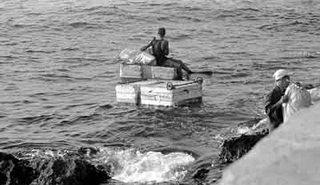 I am not sure if that is really a word, but it is an apt description of these fellows who go "deep-sea fishing" spending the night at sea in hopes of a good catch. They have crafted rafts from large Styrofoam containers and old lumber. These are powered by legs and swim fins of the fishermen. They typically leave and return with the tide, almost all staying out 18-30 hours. They carry a bottle of rum, some food, water, and a big hat to protect them from the sun. Although this seems like a dangerous profession to me, those I have talked with are happy and they enjoy their work. All hope to make a good catch of good eating, tasty fish that will be sold to the better restaurants. This another of the fascinating ways the Cubans have adapted to their lives and hardships.
I am not sure if that is really a word, but it is an apt description of these fellows who go "deep-sea fishing" spending the night at sea in hopes of a good catch. They have crafted rafts from large Styrofoam containers and old lumber. These are powered by legs and swim fins of the fishermen. They typically leave and return with the tide, almost all staying out 18-30 hours. They carry a bottle of rum, some food, water, and a big hat to protect them from the sun. Although this seems like a dangerous profession to me, those I have talked with are happy and they enjoy their work. All hope to make a good catch of good eating, tasty fish that will be sold to the better restaurants. This another of the fascinating ways the Cubans have adapted to their lives and hardships.
Tuesday, March 28, 2006
Pneumatico
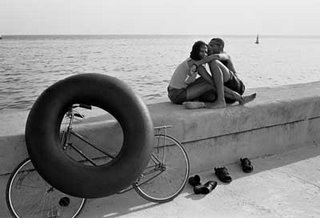 I have been away for the past week. This photo, titled "Pneumatico," shows a young fisherman, his fishing vessel (the large inner tube), and his girl friend who is welcoming him back from his day at sea fishing. This is a common sight. One can stand at the point where the ocean and the Bahia meet and watch the young men in their inner tubes with swim fins to propel them head out toward the horizon for a day's fishing. They usually have a good catch for these are productive fishing waters. Some will go in the afternoon and remain out at sea overnight which is a cooler way to go fishing.
I have been away for the past week. This photo, titled "Pneumatico," shows a young fisherman, his fishing vessel (the large inner tube), and his girl friend who is welcoming him back from his day at sea fishing. This is a common sight. One can stand at the point where the ocean and the Bahia meet and watch the young men in their inner tubes with swim fins to propel them head out toward the horizon for a day's fishing. They usually have a good catch for these are productive fishing waters. Some will go in the afternoon and remain out at sea overnight which is a cooler way to go fishing.
Sunday, March 19, 2006
Jaguey
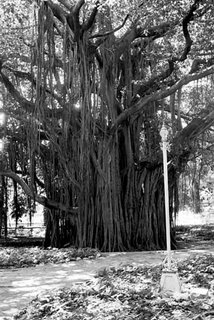 These beautiful trees are all about in Havana. This one is in the park along Avenida Cinco in Miramar. That is a nice place to walk. Many nice buildings are there and a lot of the middle and upper middle class Cubans have houses in this area. It is also the embassy areas and some homes have been taken over as government agencies and offices. The roots of the Jaguey trees grow up in the air so that the tree rests upon its roots way up above the ground. I always ask my students to figure out how they plant these trees that require above ground roots. I am not sure I know, either.
These beautiful trees are all about in Havana. This one is in the park along Avenida Cinco in Miramar. That is a nice place to walk. Many nice buildings are there and a lot of the middle and upper middle class Cubans have houses in this area. It is also the embassy areas and some homes have been taken over as government agencies and offices. The roots of the Jaguey trees grow up in the air so that the tree rests upon its roots way up above the ground. I always ask my students to figure out how they plant these trees that require above ground roots. I am not sure I know, either.
Wednesday, March 15, 2006
Along the Malecon
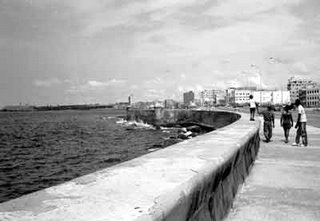 Probably the major attraction in Havana is the Malecon. This broad boulevard sweeps along the sea wall. The water and foam from breaking waves blows and sometimes flows over the wall. People fish along there, young folks hang out at night and party, families walk along in the afternoon, and often one sees some person standing looking at the sea. I wonder at them, are they looking at the sea or are they looking at Florida and their friends and family who are there?
Probably the major attraction in Havana is the Malecon. This broad boulevard sweeps along the sea wall. The water and foam from breaking waves blows and sometimes flows over the wall. People fish along there, young folks hang out at night and party, families walk along in the afternoon, and often one sees some person standing looking at the sea. I wonder at them, are they looking at the sea or are they looking at Florida and their friends and family who are there?
Saturday, March 11, 2006
Print Gallery
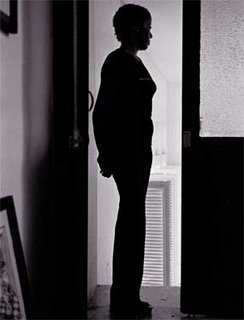 This attractive woman was the gallery manager at the graphics workshop immediately adjacent to the Catederal. In this workshop many printmakers work. Some are students. There is a gallery upstairs where prints are sold. One can purchase original art in this gallery for quite low prices. It is interesting to walk through the large area where the artists are at work and talk to them about what they are doing. These sorts of activities abound in Havana which in many regards is no different from other medium to large cities.
This attractive woman was the gallery manager at the graphics workshop immediately adjacent to the Catederal. In this workshop many printmakers work. Some are students. There is a gallery upstairs where prints are sold. One can purchase original art in this gallery for quite low prices. It is interesting to walk through the large area where the artists are at work and talk to them about what they are doing. These sorts of activities abound in Havana which in many regards is no different from other medium to large cities.
Thursday, March 09, 2006
Cross
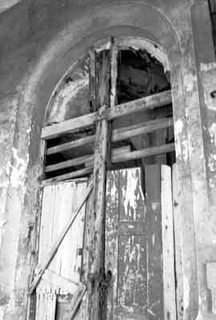 Sometimes the old lumber used to board up the falling in buildings makes unusual shapes. I thought this made a perfect cross. This building was along the malecon. There many buildings are being restored, even if the pace is quite slow. Most of the buildings along there show the wear and tear associated with being on the seafront and exposed to the tropical storms that come each summer and fall.
Sometimes the old lumber used to board up the falling in buildings makes unusual shapes. I thought this made a perfect cross. This building was along the malecon. There many buildings are being restored, even if the pace is quite slow. Most of the buildings along there show the wear and tear associated with being on the seafront and exposed to the tropical storms that come each summer and fall.
Tuesday, March 07, 2006
Mercado
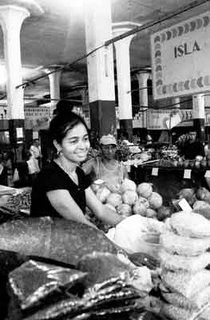 Another photo from the market. This attractive young woman is doing a brisk business in her vegetables and fruit. Most people are happy to smile and let you make their picture. I always spend at least one afternoon in this market when I visit. It is always a hotbed of humanity-the laughter, music, smells, chatter of conversation, and the happiness that pervades is uplifting. I received an email last night. One of my friends, Ramon, just received a national award. Ramon was awarded the National Prize "Reason For Being" by the Alejo Carpentier Foundation for the book "Dictionary of Cuban Photography". Congratulations to him, he is as tireless intellectual who is a genuine polymath.
Another photo from the market. This attractive young woman is doing a brisk business in her vegetables and fruit. Most people are happy to smile and let you make their picture. I always spend at least one afternoon in this market when I visit. It is always a hotbed of humanity-the laughter, music, smells, chatter of conversation, and the happiness that pervades is uplifting. I received an email last night. One of my friends, Ramon, just received a national award. Ramon was awarded the National Prize "Reason For Being" by the Alejo Carpentier Foundation for the book "Dictionary of Cuban Photography". Congratulations to him, he is as tireless intellectual who is a genuine polymath.
Monday, March 06, 2006
Eat mor' chikn
 This chicken was ruling the roost one day in the large market, the "Free Market" at Quatro Caminos in Cerro. That is a terrific place to visit. It is full of people, food, all sorts of vegetables and fruit. Upstairs is the meat market which is sort of bloody for vegetarians to visit. There are lots of friendly people there. Things may be difficult in Cuba, but the people do seem to be able to stay friendly, helpful, and open. Outside the street is busy, nearby are several shops that sell trinkets and other paraphernalia for Santeria practitioners. This is not much of a tourist area so there are few guys on the street selling cigars, etc.
This chicken was ruling the roost one day in the large market, the "Free Market" at Quatro Caminos in Cerro. That is a terrific place to visit. It is full of people, food, all sorts of vegetables and fruit. Upstairs is the meat market which is sort of bloody for vegetarians to visit. There are lots of friendly people there. Things may be difficult in Cuba, but the people do seem to be able to stay friendly, helpful, and open. Outside the street is busy, nearby are several shops that sell trinkets and other paraphernalia for Santeria practitioners. This is not much of a tourist area so there are few guys on the street selling cigars, etc.
Friday, March 03, 2006
80-60-40
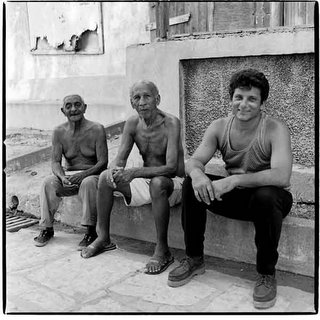 These three gentlemen were sitting out on the curb in the small fishing village just outside Havana that is named Baracoa, not to be confused with the more famous Baracoa on the eastern tip of the country. This was a quaint village with many people lingering about, not many seemed to have jobs to go to. Interestingly these three represent three generations of the same family-grandfather, father, and son. This sort of multi-generational living and socializing arrangement is very common. In almost all homes one encounters at least three generations living together in apparent harmony. That is a nice thing.
These three gentlemen were sitting out on the curb in the small fishing village just outside Havana that is named Baracoa, not to be confused with the more famous Baracoa on the eastern tip of the country. This was a quaint village with many people lingering about, not many seemed to have jobs to go to. Interestingly these three represent three generations of the same family-grandfather, father, and son. This sort of multi-generational living and socializing arrangement is very common. In almost all homes one encounters at least three generations living together in apparent harmony. That is a nice thing.
Thursday, March 02, 2006
Rosie
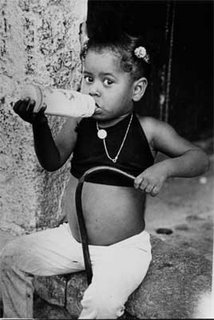 This is Rosie. She was across the street from the little boy below. She was much more animated, drinking her milk, and playing with this old bent piece of metal tubing. I met her Mom and her Dad. I took several pictures, and dropped by a few days later with some soap, Bic pens, pads, and a few Bic lighters. Rosie is more like the majority of the young kids, they do get their rations, but there is still a chronic shortage of food. I know some Moms who nurse their toddlers, in their minds it is more efficient for the mother to eat and the child to nurse. This seems to defy the law of conservation of matter and energy in my view, but I admit, I can see the logic in their thinking.
This is Rosie. She was across the street from the little boy below. She was much more animated, drinking her milk, and playing with this old bent piece of metal tubing. I met her Mom and her Dad. I took several pictures, and dropped by a few days later with some soap, Bic pens, pads, and a few Bic lighters. Rosie is more like the majority of the young kids, they do get their rations, but there is still a chronic shortage of food. I know some Moms who nurse their toddlers, in their minds it is more efficient for the mother to eat and the child to nurse. This seems to defy the law of conservation of matter and energy in my view, but I admit, I can see the logic in their thinking.
Wednesday, March 01, 2006
Soy Cuba
 This poor little fellow was in the street one afternoon in Habana Vieja. He was just standing there as a couple of other kids played. They were much more energetic. This child has a swollen belly, swollen ankles and is in the early stages of malnutrition. I suspect some one else is getting his ration of milk and meat. I realized that in spite of universal access to various services, you can't make all the people responsible and caring, no matter what you do. Unfortunately many people go to bed hungry in Cuba each night. I have had many people-Cubans and otherwise-argue with me on this point.
This poor little fellow was in the street one afternoon in Habana Vieja. He was just standing there as a couple of other kids played. They were much more energetic. This child has a swollen belly, swollen ankles and is in the early stages of malnutrition. I suspect some one else is getting his ration of milk and meat. I realized that in spite of universal access to various services, you can't make all the people responsible and caring, no matter what you do. Unfortunately many people go to bed hungry in Cuba each night. I have had many people-Cubans and otherwise-argue with me on this point. Again, an issue where the predominant shade is gray-not black or white.
Tuesday, February 28, 2006
Old door
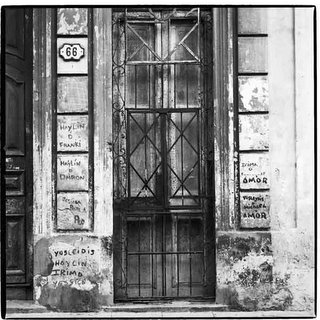 This old door with all the grafitti appealed to me. All the boys'and girls'names made me want to call it "El Puerto de l'amore." But, I wasn't sure of the Spanish, so I passed on that. I realized this morning that I had been lax in posting pictures, so I am cranked back up. I have been busy upgrading my web site, so check that out if time permits.
This old door with all the grafitti appealed to me. All the boys'and girls'names made me want to call it "El Puerto de l'amore." But, I wasn't sure of the Spanish, so I passed on that. I realized this morning that I had been lax in posting pictures, so I am cranked back up. I have been busy upgrading my web site, so check that out if time permits.
Saturday, February 25, 2006
Che Tees
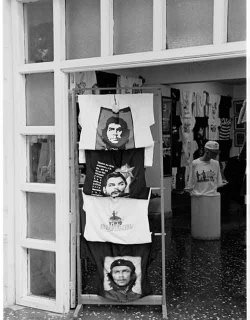 Che tee shirts are encountered the world over. There are many images of him all over Cuba. Clearly he and Mao are the two most famous revolutionaries in recent history. Che was made a martyr, probably intentionally, and has proved more useful to the revolution dead than he was alive. An intellectual, a hardcore revolutionary, a husband and father, he had no qualms about killing those who stood in the way of the revolutionary movement. It is unusual to see young Cubans wearing Che tee shirts. They do turn up at parades and rallies, but that is about it. Most of the tees are on sale to tourists. It is hilarious to see older bulky tourists in their Che Guevara berets.
Che tee shirts are encountered the world over. There are many images of him all over Cuba. Clearly he and Mao are the two most famous revolutionaries in recent history. Che was made a martyr, probably intentionally, and has proved more useful to the revolution dead than he was alive. An intellectual, a hardcore revolutionary, a husband and father, he had no qualms about killing those who stood in the way of the revolutionary movement. It is unusual to see young Cubans wearing Che tee shirts. They do turn up at parades and rallies, but that is about it. Most of the tees are on sale to tourists. It is hilarious to see older bulky tourists in their Che Guevara berets.
Friday, February 24, 2006
Chapel in Bauta
 This lovely small chapel was being cleaned by these two ladies. I wanted to take their picture, but they insisted that they must finish, put up their mops and buckets before any photos were made. There was a very nice replica of a ship, perhaps Noah's Ark, in the vestibule of the chapel. There are churches and chapels throughout Cuba. There are at least two synagogues in Havana. I have been to church (Episcopal) in Havana, there were perhaps 300-350 people there, no one seemed the least bit intimidated or nervous. All of the rumors about the suppression of the church and possession of bibles or the persecution of church going people is just not the case. It might have been years ago, but certainly since the visit of Pope John in 1998 things have changed.
This lovely small chapel was being cleaned by these two ladies. I wanted to take their picture, but they insisted that they must finish, put up their mops and buckets before any photos were made. There was a very nice replica of a ship, perhaps Noah's Ark, in the vestibule of the chapel. There are churches and chapels throughout Cuba. There are at least two synagogues in Havana. I have been to church (Episcopal) in Havana, there were perhaps 300-350 people there, no one seemed the least bit intimidated or nervous. All of the rumors about the suppression of the church and possession of bibles or the persecution of church going people is just not the case. It might have been years ago, but certainly since the visit of Pope John in 1998 things have changed.
Thursday, February 23, 2006
Checking the news in Vinales
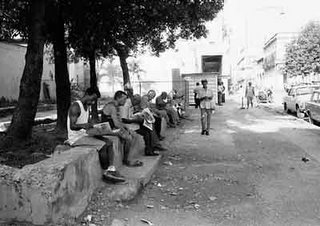 The morning paper is dutifully read, and it is one of the ways of communicating the latest antics of the government to the people. The main paper, Granma, named for the boat that brought the revolutionaries back from Mexico, is the leading goverment journal. It is typically about eight pages, costs fifty cents for tourists and a couple of pesos to the local people. These fellows are spending a lazy, hot summer afternoon, hanging out and reading the paper. Hanging out seems to be one of the major pastimes and avocations amongst the people.
The morning paper is dutifully read, and it is one of the ways of communicating the latest antics of the government to the people. The main paper, Granma, named for the boat that brought the revolutionaries back from Mexico, is the leading goverment journal. It is typically about eight pages, costs fifty cents for tourists and a couple of pesos to the local people. These fellows are spending a lazy, hot summer afternoon, hanging out and reading the paper. Hanging out seems to be one of the major pastimes and avocations amongst the people.
Wednesday, February 22, 2006
A Song for La Caridad del Cobre

The white girls lift their heads like trees
The black girls go
Reflected like flamingoes in the street.
The white girls sing as shrill as water,
The black girls talk as quiet as clay.
The white girls open their arms like clouds,
The black girls close their eyes like wings:
Angels bow down like bells,
Angels look up like toys.
Because the heavenly stars
Stand in a ring:
And all the pieces of the mosaic, earth,
Get up and fly away like birds.
------The Seven Storey Mountain, Thomas Merton, 1948
Monday, February 20, 2006
Millenium
 I made this photo in the year 2000. I liked the name of the store. This was a major store in a major shopping area. There were what had once been nice shops and boutiques along the street. They were all now empty and closed, or barely open as peso stores. Over the past five years, the area has made a slight come back as more tourist hotels have opened nearby, and there are actually a few shoppers. The department store remains closed and in disrepair. It is not unreasonable that this has happened. Most of the elites and the upper middle class Cubans departed early in the history of the revolution. As the people from the country side moved into the city, they had to learn how to finction in the city. By the time they were educated and ready for assimilation into society, they had been indoctrinated into the great middling effect of revolutionary thinking. The 1900s were in fact a final century for a way of life in Cuba. Things have changed for the better and the worse, but they will never return to the way they were in the last mid-century.
I made this photo in the year 2000. I liked the name of the store. This was a major store in a major shopping area. There were what had once been nice shops and boutiques along the street. They were all now empty and closed, or barely open as peso stores. Over the past five years, the area has made a slight come back as more tourist hotels have opened nearby, and there are actually a few shoppers. The department store remains closed and in disrepair. It is not unreasonable that this has happened. Most of the elites and the upper middle class Cubans departed early in the history of the revolution. As the people from the country side moved into the city, they had to learn how to finction in the city. By the time they were educated and ready for assimilation into society, they had been indoctrinated into the great middling effect of revolutionary thinking. The 1900s were in fact a final century for a way of life in Cuba. Things have changed for the better and the worse, but they will never return to the way they were in the last mid-century.
Subscribe to:
Posts (Atom)